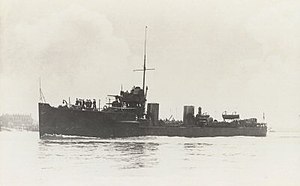fleet.wikisort.org - Ship
HMS Derwent was a Hawthorn Leslie-type River-class destroyer ordered by the Royal Navy under the 1901 – 1902 Naval Estimates. Named after the River Derwent in central England, she was the second ship to carry this name.
 HMS Derwent | |
| History | |
|---|---|
| Name | Derwent |
| Ordered | 1901 – 1902 Naval Estimates |
| Builder | R.W. Hawthorn Leslie and Company, Ltd, Newcastle-upon-Tyne |
| Laid down | 12 June 1902 |
| Launched | 14 February 1903 |
| Commissioned | June 1904 |
| Fate | Mined, 2 May 1917 |
| General characteristics | |
| Class and type | Hawthorn Leslie Type River Class destroyer[1][2] |
| Displacement |
|
| Length | 226 ft 6 in (69.04 m) o/a |
| Beam | 23 ft 9 in (7.24 m) |
| Draught | 7 ft 9 in (2.36 m) |
| Installed power | 7,000 shp (5,200 kW) |
| Propulsion |
|
| Speed | 25.5 kn (47.2 km/h) |
| Range |
|
| Complement | 70 officers and men |
| Armament |
|
| Service record | |
| Part of: |
|
| Operations: | World War I 1914 - 1918 |
Construction
She was laid down on 12 June 1902 at the Hawthorn Leslie shipyard at Hebburn-on-Tyne and launched on 14 February 1903. She was completed on 1 July 1904. Her original armament was to be the same as the turtleback torpedo boat destroyers that preceded her. In 1906 the Admiralty decided to upgrade the armament by landing the five 6-pounder naval guns and shipping three 12-pounder 8 hundredweight (cwt) guns. Two were mounted abeam at the foc'x'le break and the third gun was mounted on the quarterdeck.
Pre-War

After commissioning she was assigned to the East Coast Destroyer Flotilla of the 1st Fleet and based at Harwich.
In April 1909 she was assigned to the 3rd Destroyer Flotilla on its formation at Harwich. She remained until displaced by a Beagle-class destroyer by May 1912. She was assigned to the 5th Destroyer Flotilla of the 2nd Fleet with a nucleus crew.
On 30 August 1912 the Admiralty directed that all destroyer classes were to be designated by letters. The ships of the River class were assigned to the E class. After 30 September 1913, she was known as an E-class destroyer and had the letter ‘E’ painted on the hull below the bridge area and on either the fore or aft funnel.[3]
World War I
In early 1914 when displaced by G-class destroyers she joined the 9th Destroyer Flotilla based at Chatham tendered to HMS St George. The 9th Flotilla was a patrol flotilla operating anti-submarine and counter-mining patrols in the Firth of Forth area. By September 1914, she was deployed to the Dover Patrol based at Portsmouth. Here she provided anti-submarine and counter-mining patrols and defended the Dover Barrage.[4]
In August 1915 with the amalgamation of the 7th and 9th Flotillas,[5] she was assigned to the 1st Destroyer Flotilla when it was redeployed to Portsmouth in November 1916. She was equipped with depth charges for use in anti-submarine patrols, escorting of merchant ships and defending the Dover Barrage. In the spring of 1917 as the convoy system was being introduced the 1st Flotilla was employed in escort duties for convoys through the English Channel for the remainder of the war.
Loss
On 2 May 1917 she struck a contact mine, laid by German submarine UC-26, off Le Havre, France. She sank 2 cables north of Whistle Buoy at position 49°31′N 00°02′W with the loss of 58 officers and men.[6]
Pennant numbers
| Pennant number[7] | From | To |
|---|---|---|
| N25 | 6 Dec 1914 | 1 Sep 1915 |
| D15 | 1 Sep 1915 | 18 Jun 1916 |
References
- Jane, Fred T. (1969) [1905]. Jane’s Fighting Ships 1905/6. New York: first published by Sampson Low Marston, London 1905, Reprinted ARCO Publishing Company. p. 75.
- Jane, Fred T. (1990) [1919]. Jane’s Fighting Ships of World War I. Jane’s Publishing. p. 76. ISBN 1 85170 378 0.
- Conway’s All the World’s Fighting Ships 1906 to 1922. Conway Maritime Press. 2006. pp. 17–19. ISBN 0 85177 245 5.
- "Naval Database".
- Corbett, Sir Julian S, "Chapter XIII, Home Waters September 1915‑March 1916, and the Cruise of the German Raider Moewe", Loss of Argyl and Natal, History of the Great War, Naval Operations, vol. III Spring 1915 to June 1916, The Naval & Military Press Ltd, retrieved 1 June 2013
- "Loss data from U-Boat.net".
- ""Arrowsmith" List: Royal Navy WWI Destroyer Pendant Numbers". Retrieved 3 February 2009.
Bibliography
- Chesneau, Roger & Kolesnik, Eugene M., eds. (1979). Conway's All The World's Fighting Ships 1860–1905. London: Conway Maritime Press. ISBN 0-85177-133-5.
- Colledge, J. J.; Warlow, Ben (2006) [1969]. Ships of the Royal Navy: The Complete Record of all Fighting Ships of the Royal Navy (Rev. ed.). London: Chatham Publishing. ISBN 978-1-86176-281-8.
- Dittmar, F.J.; Colledge, J. J. (1972). British Warships 1914–1919. Shepperton, UK: Ian Allan. ISBN 0-7110-0380-7.
- Friedman, Norman (2009). British Destroyers: From Earliest Days to the Second World War. Barnsley, UK: Seaforth Publishing. ISBN 978-1-84832-049-9.
- Gardiner, Robert & Gray, Randal, eds. (1985). Conway's All The World's Fighting Ships 1906–1921. London: Conway Maritime Press. ISBN 0-85177-245-5.
- Manning, T. D. (1961). The British Destroyer. London: Putnam & Co. OCLC 6470051.
- March, Edgar J. (1966). British Destroyers: A History of Development, 1892–1953; Drawn by Admiralty Permission From Official Records & Returns, Ships' Covers & Building Plans. London: Seeley Service. OCLC 164893555.
Другой контент может иметь иную лицензию. Перед использованием материалов сайта WikiSort.org внимательно изучите правила лицензирования конкретных элементов наполнения сайта.
WikiSort.org - проект по пересортировке и дополнению контента Википедии